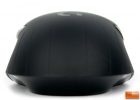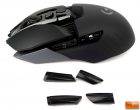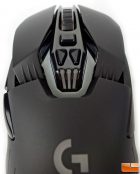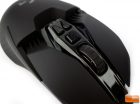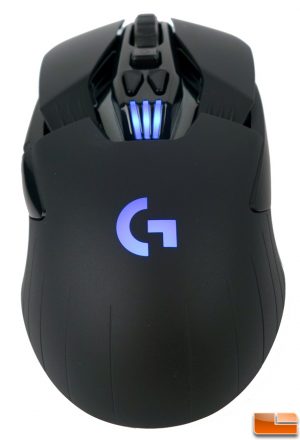Logitech G900 Chaos Spectrum Wireless Gaming Mouse Review
Logitech G900 Chaos Spectrum Wireless Gaming Mouse Closer Look
The Logitech G900 Chaos Spectrum gaming mouse is average sized at 130 mm x 67 mm x 40 mm but very light, coming in at just 107 grams. This may be a good or bad thing depending on your preference as some like heavier mice to help prevent any unwanted motion and feel they can better finely control something with a little more heft. I don’t really have a preference either way and I think it depends on the shape/size of the mouse and how it fits your hand. This one fits very comfortably in my hand using either a claw or palm type grip. I think most will find the same.
Looking down on the G900, you can see it’s symmetrical in design because it’s meant to be ambidextrous. It’s not one molded piece with a few buttons thrown in but more of a pieced together design with a shell on the rear and a front lower and upper section. On the bottom, there are four large skates for it to glide on with the Pixart PMW3366 optical sensor hanging out in the middle and an on/off switch and a sync switch toward the back. While on that topic, I never even had to use the sync button, I just connected the transmitter to a USB port and bingo, it connected right away.
As mentioned, the rear piece is unremarkable, just a palm rest with the G logo. From the front, the USB port is visible, as are the scroll wheel and the scroll shift button that sits behind. From this angle, it looks like it means business. On the sides, by default you have the forward/back buttons on the left and a solid plastic piece across the same area on the opposite side.
These pieces are actually removable so that you can switch it to be left-handed or even have two buttons on each side in the event you’d like a few more for something like macros. They are held on with magnets though if you didn’t know they came off, there’s nothing to indicate that that do. They don’t feel loose or temporary in any way which is excellent precision construction.
A closer look at the top reveals the ridged hyper scroll wheel with the scroll shift button behind it. This button changes the wheel mode from ratcheted spinning to free spinning and the only button not programmable as it’s mechanical only. The free-spin mode is marvelous for using on spreadsheets, long documents, or web pages. Not so good for gaming so it’s great to have a choice. The hyper scroll wheel also allows for side-scrolling with a nudge to tilt it to the left or right. Again, super handy.
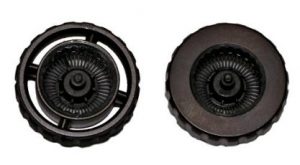 If you were to remove the wheel, you’d see it’s partially hollow with spokes a thin-wall construction as compared to the one from the G502 Proteus Spectrum. Logitech claims a 47% reduction in the wheel weight as a result.
If you were to remove the wheel, you’d see it’s partially hollow with spokes a thin-wall construction as compared to the one from the G502 Proteus Spectrum. Logitech claims a 47% reduction in the wheel weight as a result.
Just behind the scroll shift button are two small buttons side by side and these are the DPI switching buttons. Intuitively, the button to the left decreases and the one to the right increases the sensitivity in increments that are preset in the software. The three elongated lights that sit behind this are the DPI preset indicator where the first will be lit for preset number one, two for the second, all three for the third, and then for the fourth the first lit goes out, and finally on the fifth preset only the one on the right is lit. However, this lighting is temporary as after a few seconds all of the lights extinguish. This is to save battery power and can be disabled completely to even further help the battery if it’s something you change a lot and don’t care about the indicators. The logo toward the rear is RGB lit based on preferences in the software or can be turned off as well since it’s one more battery drain. Speaking of the software, that’s up next.





